
Deposition Date
2008-01-11
Release Date
2008-07-08
Last Version Date
2024-10-30
Entry Detail
PDB ID:
3BX1
Keywords:
Title:
Complex between the Barley alpha-Amylase/Subtilisin Inhibitor and the subtilisin Savinase
Biological Source:
Source Organism:
Bacillus lentus (Taxon ID: )
Host Organism:
Method Details:
Experimental Method:
Resolution:
1.85 Å
R-Value Free:
0.23
R-Value Work:
0.20
R-Value Observed:
0.20
Space Group:
P 41 21 2


